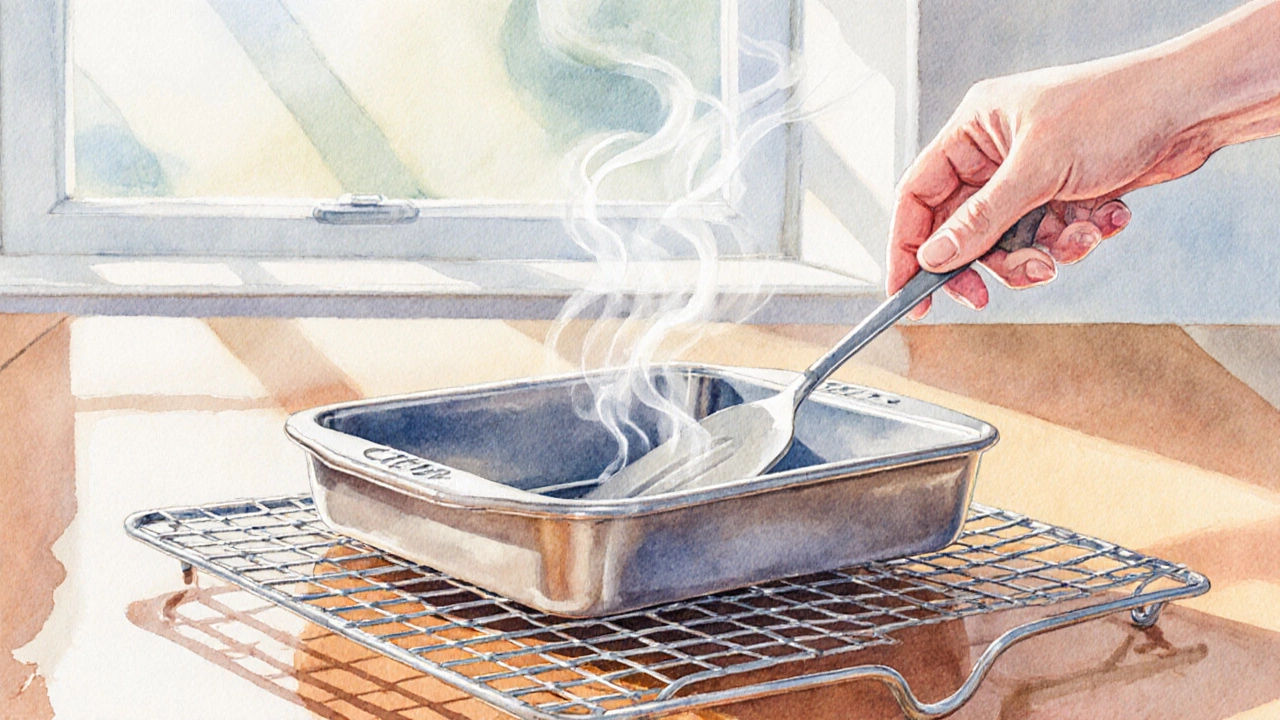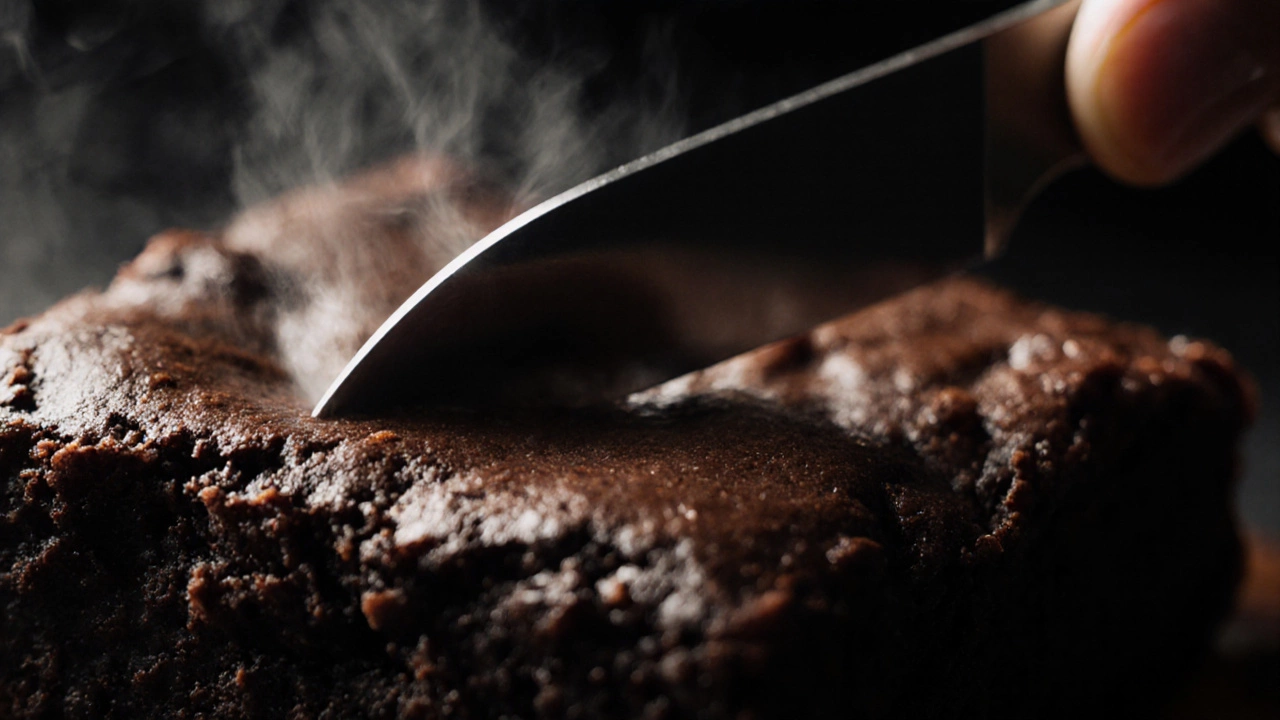Brownie Resting Time Calculator
Why resting matters: Chocolate is a fat-based emulsion. When cooled, cocoa butter recrystallizes to create the firm bite. Skipping rest causes crumbling and sticking.
Calculate Your Brownie Rest Time
How This Works
The calculator adjusts for key factors from the article: pan material, room temperature, and thickness.
Recommended range: Always aim for the lower end if you prefer fudgy centers, or the higher end for firmer texture.
When you pull a tray of Brownies are dense, chocolatey squares that can be fudgy or cakey, usually baked in a shallow pan out of the oven, the next step-letting them rest-determines whether they stay gooey or become dry.
Why Resting Matters
Heat doesn’t disappear the instant you open the oven door. The center of the Brownies can stay a few degrees hotter than the edges for several minutes. During that time the melted butter and chocolate continue to solidify, allowing the crumb to set evenly. Skipping the rest means you’ll cut into a still‑soft interior, causing the pieces to crumble or stick to the knife.
The Science Behind the Cool‑Down
Chocolate Chocolate is a fat‑based emulsion. When it’s heated, the cocoa butter becomes liquid, giving brownies that shiny, moist look. As the bake cools, the cocoa butter recrystallizes, creating the firm bite we associate with a good brownie. The rate of recrystallization depends on a few key variables:
- Oven temperature: Higher temps leave more residual heat, extending the natural set‑up time.
- Pan material: Metal pans conduct heat quickly, while glass retains it longer.
- Brownie thickness: Thicker layers retain heat deeper in the center.
Understanding these factors lets you predict the ideal brownie resting time for any recipe.
Typical Resting Times by Brownie Style
Not all brownies are created equal. A Fudgy brownie with a high butter‑to‑flour ratio behaves differently from a Cakey brownie that relies more on leavening. Below is a quick reference that works for most home ovens (350°F / 175°C).
| Brownie Type | Typical Thickness (inches) | Recommended Rest (minutes) |
|---|---|---|
| Fudgy | 1.0 | 15‑20 |
| Cakey | 0.75 | 10‑12 |
| Gluten‑Free | 0.8 | 12‑15 |
| Brownie Bars (cut into squares) | 0.5 | 5‑8 |
| Large Sheet (professional size) | 2.0 | 25‑30 |
These numbers are a starting point. If you love a super‑gooey center, aim for the lower end; if you prefer a firmer bite, let them sit a bit longer.

Factors That Can Shift the Clock
Even with a solid baseline, real‑world variables will push the timing up or down. Keep an eye on these.
- Pan type: A Baking pan made of dark, non‑stick metal absorbs more heat, often requiring an extra 2‑3 minutes of rest.
- Cooling surface: Placing the pan directly on a Cooling rack speeds heat dissipation. If you leave the pan on the countertop, the bottom stays warm longer.
- Room temperature: A chilly kitchen (60°F/15°C) will shorten resting time, while a warm kitchen can add a few minutes.
- Ingredient swaps: Using oil instead of butter reduces the solid‑fat content, meaning the crumb sets quicker. Conversely, extra cocoa powder can hold moisture longer.
Step‑by‑Step Cooling Routine
- When the timer dings, turn off the oven but keep the door ajar for 2‑3 minutes. This gentles the temperature drop.
- Remove the Brownies pan and set it on a pre‑heated Cooling rack. The rack should be sturdy enough to support the pan without bending.
- If you’re in a hurry, gently lift the baked slab with a spatula, place it on a large sheet of parchment, and let it rest on the counter. This method reduces contact with the hot metal.
- After the minimum time from the table above, run a thin knife or offset spatula along the edge to see if the crumb holds together. If it slides, add 2‑3 more minutes.
- When the brownies feel firm to the touch and the edges have set, cut them into squares. For extra clean cuts, dip the knife in hot water, wipe dry, and slice.
Following this routine gives consistent results, whether you’re baking a single batch for friends or a full‑size tray for a party.
Special Cases: Gluten‑Free and Vegan Brownies
Gluten‑free versions often replace flour with almond meal or oat flour, which absorb moisture differently. Expect a slightly longer rest-about 2‑4 minutes beyond the standard suggestion-so the crumb can fully bind. Vegan brownies that swap butter for coconut oil behave similarly to butter‑based recipes, but the oil solidifies at a higher temperature, meaning a brief extra rest can help achieve that classic fudgy snap.

Common Mistakes and How to Avoid Them
- Cutting too early: The obvious culprit. Even a 5‑minute rest can make a big difference.
- Leaving the pan on a cold surface: A chilly countertop can cause the bottom to firm too fast, leading to uneven texture.
- Re‑warming the brownies: Some bakers pop the tray back in the oven to “finish” the bake. This can overcook the edges and ruin the intended moisture.
- Skipping the air‑release step: After the initial 2‑minute oven door opening, gently swing the pan a few times to release trapped steam. It prevents soggy bottoms.
Quick Reference Cheat Sheet
- Fudgy, 1‑inch thick: 15‑20min
- Cakey, 0.75‑inch thick: 10‑12min
- Gluten‑free, 0.8‑inch thick: 12‑15min
- Large sheet, 2‑inch thick: 25‑30min
- All types: add 2‑3min for dark metal pans or warm kitchens
Keep this cheat sheet taped to your fridge, and you’ll never wonder again whether your brownies need more time.
Frequently Asked Questions
Can I refrigerate brownies right after baking?
It’s best to let them rest at room temperature first. Refrigerating too soon makes the crust hard and the interior gummy. After the usual rest, you can chill them for a firmer texture or to store them longer.
Do I need to cool brownies before frosting them?
Absolutely. A warm surface will melt most frostings, turning them into a glaze. Wait at least the minimum rest time, then let the slab cool completely before spreading any icing.
Why do some recipes say “cool completely” while others say “rest for 10 minutes”?
“Cool completely” is usually a precaution for delicate decorations or for making brownies that will be layered. “Rest for 10 minutes” is a shortcut that ensures the crumb sets enough for clean cutting without waiting an hour.
Will a silicone pan change my resting time?
Silicone conducts heat more slowly, so the center stays warmer a bit longer. Add an extra 2‑4 minutes to the recommended rest for the same brownie style.
Is it okay to cover the pan with foil while the brownies rest?
Covering traps steam, which can make the top soggy. If you must cover, use a loose foil tent and remove it after the first 5 minutes to let excess moisture escape.